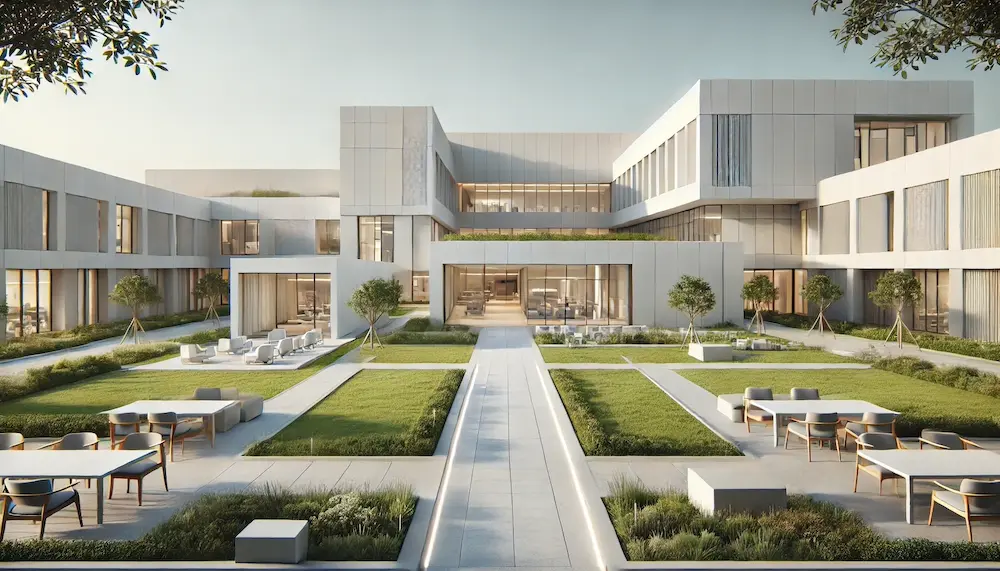Minimalist hospital architecture emphasizes simplicity, functionality, and the elimination of unnecessary elements to create serene and efficient healing environments. By focusing on clean lines, open spaces, and natural light, this design approach aims to reduce stress for patients and staff, promoting well-being and recovery.
History and Origins of Minimalist Hospital Architecture
The minimalist movement in architecture gained prominence in the mid-20th century, influenced by modernist principles that favored function over form. In healthcare design, this translated to hospitals that prioritize patient needs, operational efficiency, and adaptability. Early examples include Scandinavian hospitals, where designers incorporated minimalist aesthetics to enhance patient care. For instance, Haraldsplass Hospital in Norway showcases clean lines and integration with natural landscapes, reflecting minimalist principles.
Key Features of Minimalist Hospital Architecture
- Simplicity and Functionality: Designs eliminate superfluous details, focusing on essential elements that serve clear purposes. This approach enhances wayfinding and reduces visual clutter, contributing to a calming environment.
- Natural Light and Open Spaces: Large windows and open layouts maximize natural light, creating bright and airy interiors that can improve patient mood and recovery times. For example, the Royal Children’s Hospital in Melbourne utilizes extensive glazing to bring in daylight and connect occupants with the surrounding parkland.
- Use of Natural Materials: Incorporating materials like wood and stone adds warmth and a sense of tranquility, counteracting the sterile feel often associated with hospitals. The Gandel Wing at Cabrini Malvern Hospital in Australia employs natural slatted terracotta and wood to create a peaceful atmosphere.
- Integration with Nature: Designs often include gardens, courtyards, or views of natural landscapes, providing therapeutic benefits and promoting healing. The Rehab Center in Basel, designed by Herzog & de Meuron, features light-filled spaces surrounded by gardens, enhancing patient well-being.
Applications of Minimalist Hospital Architecture
- Patient Rooms: Minimalist design in patient rooms reduces distractions, providing a restful environment conducive to healing. Elements such as uncluttered spaces, natural light, and soothing color palettes are commonly used. The Hillcrest Hospital in Cleveland features minimalist interiors complemented by an art program, creating a museum-like atmosphere that promotes tranquility.
- Public Areas: Waiting rooms, reception areas, and corridors designed with minimalist principles can reduce stress and anxiety for visitors and patients. Open layouts, comfortable seating, and natural light contribute to a welcoming environment. The Royal Children’s Hospital in Melbourne incorporates nature-inspired designs in public areas to create a sense of fun and discovery, moving away from traditional sterile hospital aesthetics.
- Specialized Treatment Centers: Facilities like cancer centers benefit from minimalist designs that provide calm and focus. The University of Arizona Cancer Center at Dignity Health St. Joseph’s Hospital features a minimalist brise-soleil that reduces glare and heat, enhancing patient comfort.
Considerations When Choosing Minimalist Hospital Architecture
- Patient Experience: Ensure that minimalist designs do not become overly austere, which could feel cold or unwelcoming. Balancing simplicity with elements that provide comfort and warmth is crucial. Incorporating natural materials and access to nature can enhance the healing environment.
- Operational Efficiency: Designs should facilitate efficient workflows for medical staff, with logical layouts that minimize travel distances and enhance communication. The use of open spaces and clear sightlines can improve staff efficiency and patient monitoring.
- Flexibility and Adaptability: Hospitals must accommodate evolving medical technologies and changing patient needs. Minimalist designs often feature modular elements and open floor plans that can be reconfigured as necessary. The use of movable partitions and adaptable furniture can provide flexibility for future changes.
Conclusion
Minimalist hospital architecture offers a compelling approach to healthcare design, emphasizing simplicity, functionality, and a focus on patient well-being. By incorporating natural light, open spaces, and thoughtful material choices, minimalist designs can create healing environments that benefit patients and staff alike. Careful consideration of patient experience, operational needs, and adaptability will ensure that minimalist hospitals meet the demands of modern healthcare while providing serene and efficient spaces for healing.
